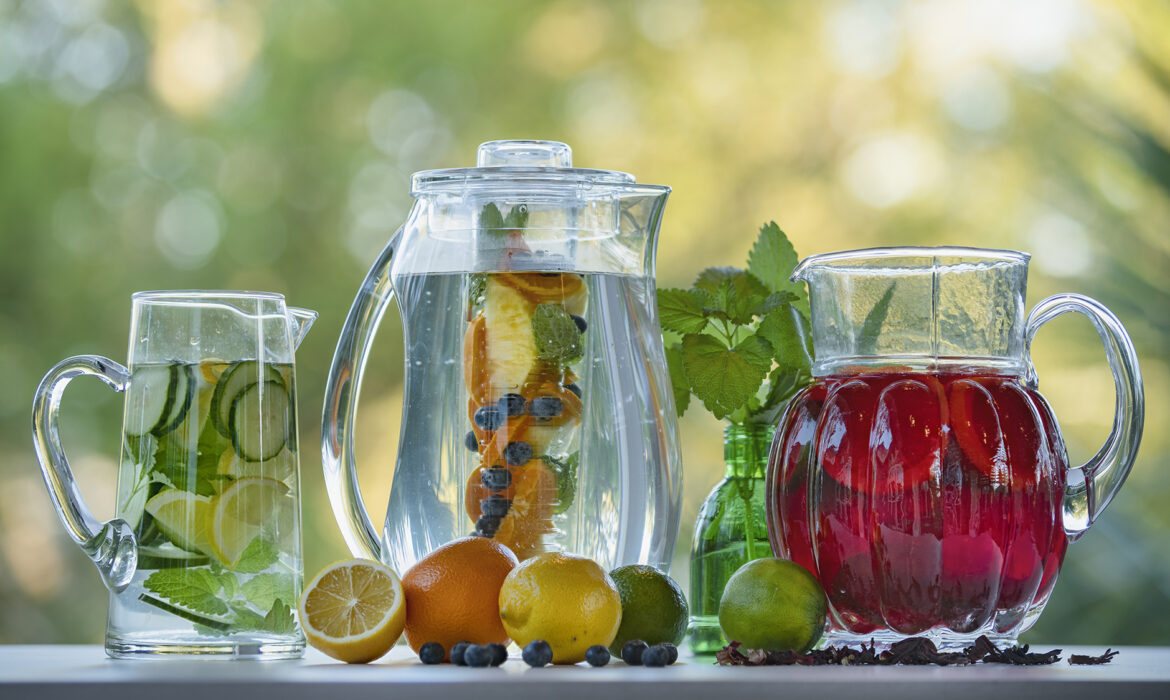Raise your hand if you’ve ever headed out to the garden on a hot summer day for a quick 10-minute task and ended up spending a couple of hours outdoors, underhydrated and without sun protection. One task leads to another and before you know it you are thirsty, sweaty, sunburned and a potential candidate for heat exhaustion. I am guilty and pledged a long time ago to be more sensible in the way I approach my summertime gardening activities. As we enter the hottest months of the year, sizzling heat, intense sun and strenuous garden chores can be a dangerous combination, especially for those who are not accustomed to working in Texas heat. Thirst is the cue that the body needs fluid replenishment, but sometimes that signal is ignored or isn’t recognized until after dehydration has already set in. Older individuals tend to have fewer fluid reserves, often coupled with a reduced sensation of thirst, so they may need to push their fluid intake even when not thirsty.
Water needs vary depending on body size, gender, level of physical activity and outdoor temperature, but general guidelines from the National Academy of Medicine recommend approximately 9-1/2 cups a day for women and 12 cups a day for men. These numbers include water from all beverages, such as coffee, tea, juice and milk. The foods that we eat also contribute to our total fluid intake. Seasonal summer produce — watermelon, cucumbers and papaya, for example — are more than 90% water. Whether you are eating them raw, adding them to a salad, enjoying a refreshing bowl of gazpacho or using them to make an invigorating beverage, they will help replenish losses.
It’s easy to be lured by the marketing hype of colorful sports drinks, detox brews and vitamin water with clever names and flavors, but water is really what our bodies crave — it’s free, it’s safe, it’s readily available and contains no sweeteners, additives or calories. Boost the appeal of the water you drink at home by infusing it with the subtle flavor of summer’s produce. To get you started, here are some tasty and easy combinations for DIY infused waters:
Blueberries + orange
Cucumber + lime
Pear + ginger
Pineapple + orange + mint
Strawberries + basil + lemon
Watermelon + lime + basil
Slice fruit into a pitcher or other container, add a few springs of herbs, fill with water and then chill. I like to use one-quart glass Mason jars for a visual cue of how much water I am actually drinking throughout the day. For a more robust flavor, muddle the fruit and herbs before adding water. I refill my jars with water once or twice, but after two days the fruit goes into the compost pile and I start a fresh batch. Be sure to wash all produce before using.
There is no set recipe for making infused water, but it is an easy way to take advantage of your garden’s bounty and hydrate yourself in the summertime. Experiment with different flavors and amounts to find what suits your taste and quenches your thirst. Other fragrant herbs from the garden might include lemon verbena, orange or pineapple mint, lemongrass, peppermint, sage, spearmint and lemon balm.
Take your hydration efforts one step further by adding fruits to herbal tea made from roselle, a hibiscus relative also known as Jamaica sorrel or flor de Jamaica. Roselle (Hibiscus sabdariffa) is a heat-loving, shrubby ornamental with red stems and lovely blooms that resemble okra. The blooms are followed by deep red calyxes that can be dried and steeped to make tea. Both Red Zinger tea from Celestial Seasonings and Tazo Passion tea get their rosy hue from roselle. You can grow your own in a vegetable garden, an edible landscape or a large container. Roselle needs warm weather, so plant seed or transplants about the same time you plant okra. Give it full sun and plenty of space, as it can grow 3–4 feet tall.
Another way to embellish your summer beverages is to make ice cubes with seasonal fruit, citrus peel or edible blooms. Depending on the size of your ice-cube trays use blueberries, pomegranate seeds, blackberries, raspberries, grape halves — any fruit that fits in the tray will work. For edible flowers, try borage, lavender or rose petals. Arrange in an ice-cube tray, cover with distilled water and freeze. Pop out and add to a glass of herbal tea or water. Or simply spread whole grapes, watermelon cubes, cantaloupe balls or berries on a parchment-lined tray, freeze and store in a sealed bag or container. Add frozen fruit to a tall glass of tap water, sparkling water or even a bubbly beverage like Prosecco.
Summer living is casual and easy, but in Texas it’s also sweltering and dehydrating. During this inevitable time of blistering heat, avoid the hottest part of the day by planning garden time for early mornings and late evenings. Stay hydrated, use sun protection and always pay attention to heat advisories. tg
SIDEBAR 1:
Hibiscus Tea
Other names for roselle include Jamaican sorrel and Florida cranberry, both of which hint at its tartness. After steeping, if the pucker power is too strong, sweeten to taste with a splash of white-grape juice, honey, stevia, simple syrup or the sweetener of your choice.
2 quarts water
1 cup dried roselle (or 6–8 hibiscus teabags)
Bring water to a simmer and pour over dried roselle or tea bags. Cover and steep 5–8 minutes. Strain and chill. Add citrus slices and a squeeze of lime, if desired.
SIDEBAR 2:
ROSELLE SEED SOURCES
- Baker Creek Heirloom Seeds
(417) 924-8917
www.rareseeds.com
- Renee’s Garden Seeds
(831) 335-7228
www.reneesgarden.com
- Southern Exposure Seed Exchange
(540) 894-9480
www.southernexposure.com

